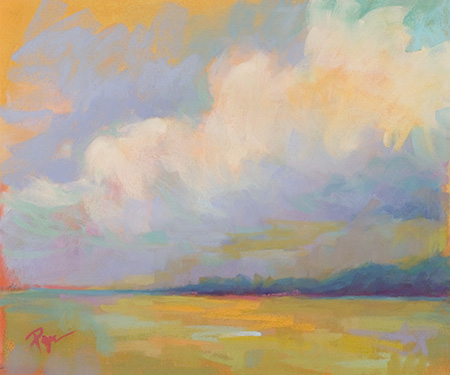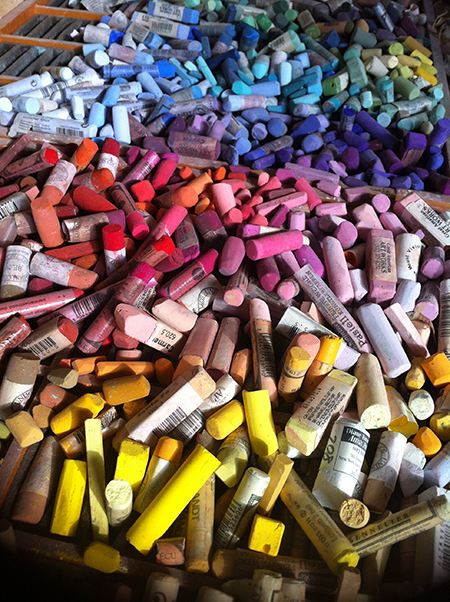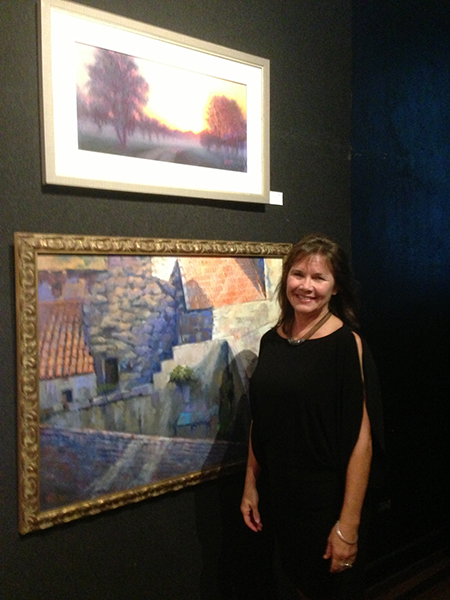
“What is Pastel?”
I am asked this question a lot.
People think of soft, light colors when they hear the word pastel.
I like to explain that the origin of the word pastel comes from the French word pastische, via the Italian word pastello, meaning paste. As pastels are made, powdered pigment is combined with water and binder, which turns into a paste. The paste is then rolled out into sticks and dried. The softer the pastel, the more pigment it has and the less binder. Pastels are made from the same pigment used in other mediums such as oil, watercolor, and acrylic, but the pigment is held together with a light glue or binder called methylcellulose.
Many people confuse soft pastels with oil pastels. Instead of the light glue, oil pastels are made with beeswax, pigment, and other chemicals and have a waxy, crayon-like character. Soft pastels and oil pastels are not the same and cannot be combined.
Whenever I do a pastel demonstration, I often get the question, “Is that chalk?” I say, “Well, it may look like chalk, but it isn’t. Chalk is made of limestone and dye. Pastels are almost pure pigment.”

This is one of the reasons people love pastels . . . the pure, brilliant colors. In fact, under the microscope a particle of pastel pigment has facets like a diamond. They have light-scattering properties and practically shimmer!
Another question people frequently ask is “Do you teach art lessons?” The answer is “Yes!” Teaching art started organically for me. As it turns out, I love to share information. I studied Studio Art at the University of South Carolina and worked as an Art Director for Rawle Murdy for years before dedicating myself to painting full time in 1996. During art shows and gallery openings, I found myself sharing more and more information with anyone and everyone that asked. My friends encouraged me to start an art class. So, I started doing demonstrations and workshops, and my classes grew. I have taught many classes locally and internationally including in Charleston, the Southeast, and in Spain.
Since art is my passion, I am gratified to share my knowledge and help people explore their authentic ‘art spirit’ and voice. I feel each person has their own artistic voice, just like everyone has their own handwriting. And each of us in the arts has an art spirit. I think teachers can squash a student’s art spirit pretty easily if they are overly critical too soon. It takes a lot of bravery to even go to an art class. I don’t want to teach people to paint like me. I want them to paint as themselves, their expression. One of my favorite books is the Art Spirit by Robert Henri—my approach comes from his amazing teachings. So many people say, “Oh, I can’t even draw a stick figure.” I always say, “You are probably more creative than you know. Anyone can learn to draw!” In short, I love to learn and I love to share what I have learned.
As an artist and a teacher, I continue to seek new information and inspiration. One of the most inspiring events for me was the Pastel Society of America’s 2013 National Show – Enduring Brilliance. From over 1,000 pastels entered, the judges chose 175. I was over the moon to be included in this competitive show. The show is held each year at the National Arts Club at Gramercy Park in New York City, and judged by master pastelists. It is a diverse and exciting show featuring a wide range of styles from highly representational to abstract.

My daughter, sister, and niece accompanied me to New York to see the show. We had a girls’ weekend, attending the reception and basking in the excitement. As I was entering the beautiful and sumptuous Grand Gallery of the National Arts Club, I could barely contain myself. The pieces were inspiring, diverse, and moving. Master pastelist Richard McKinley, PSA, gave a critique during the reception, which was a class in art appreciation itself. I oohed and aahed over the amazing works of art AND all the pastels supplies for sale—an artist can never have too many pastels! I returned to Charleston with renewed energy and perspective to share with my students.
I am very proud to be affiliated with and teach for the Gibbes Museum. Through the classes at the Hazel Parker Community Center, I am able to give back to the community and share my passion for art and the pastel medium. I have been fortunate to have amazing teachers. It is my hope to pass it on.
I am currently represented by Sandpiper Gallery on Sullivan’s Island and Edward Dare Gallery on Broad Street in downtown Charleston, SC. Please visit www.tammypapa.com to see additional examples of my work. And I hope you will sign up for a class at the Gibbes!
—Tammy Papa, Artist, Teacher, and Guest Blogger
Published March 20, 2014

